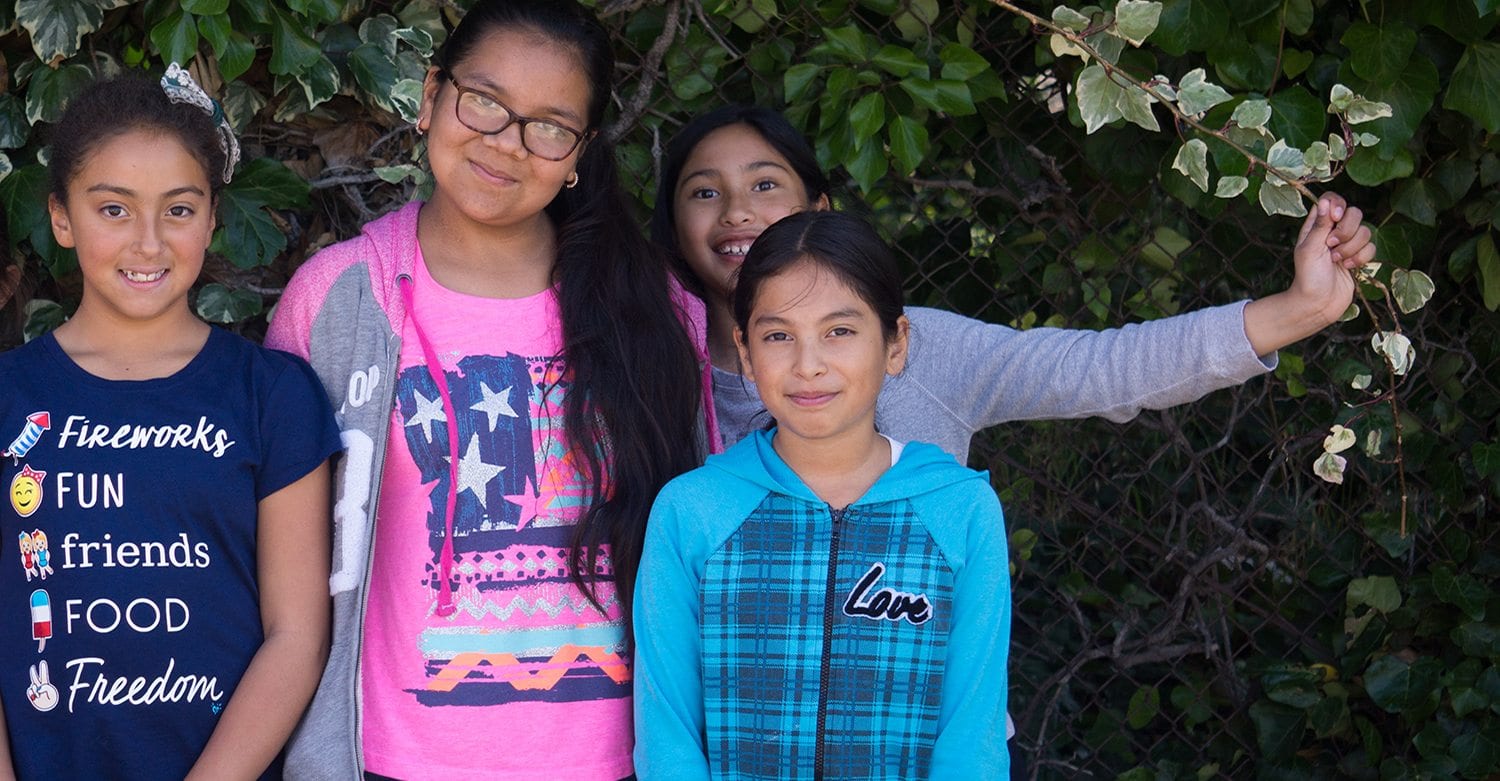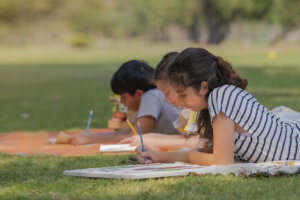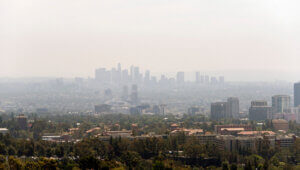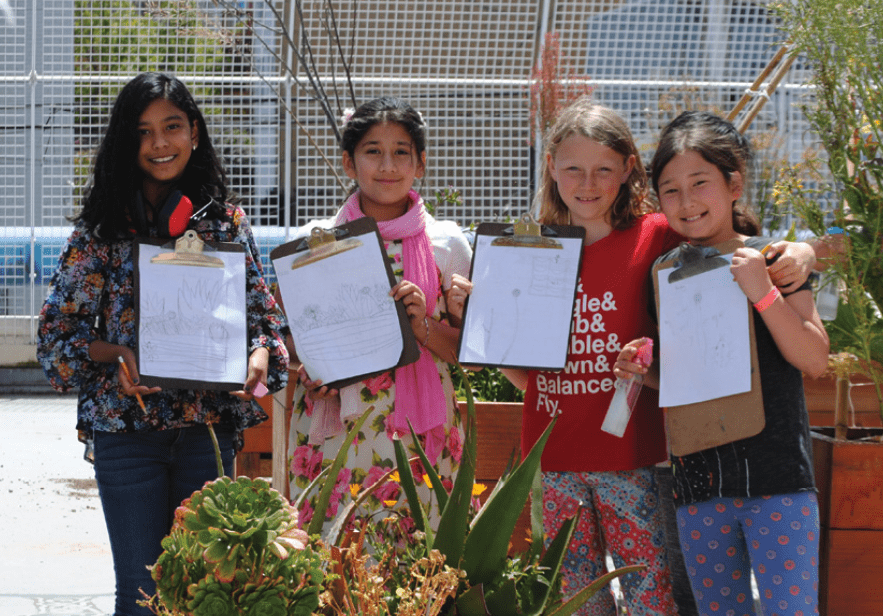There are countless ways to create positive, lasting experiences that nurture an empathetic relationship with the environment. Getting students outdoors is just one way; some common examples are investigating solutions to combat campus pollution or harmful air quality, growing school plants to observe their unfolding natural processes, or inviting a fun, interactive presentation conducted by a visiting nature leader. All of these experiences promote positive human impact on natural systems, mastery of scientific concepts, and an enhanced understanding of a healthy community as one that sustains a healthy environment. The more consistently students experience this, the easier it becomes to question policies or activities that are harmful to our planet’s ecosystems later in life.
A crucial outcome of teaching environmental literacy is to grow a sustainable way of thinking about the human relationship with the environment for our students. Environmental literacy is a way of investing in future leaders who will grow up learning that robust ecosystems are necessary for healthy communities, and that technology can evolve symbiotically with nature at all levels of society. As we develop statewide systems for teaching environmental literacy, our actions must reflect California’s diverse range of economic and educational opportunities, and the lived experiences of different communities. This includes addressing the inequitable distribution of access to nature that is caused by urban planning, which is an unseen yet important factor in how students develop their relationship with nature.
Carl Anthony and Dr. Paloma Pavel, co-founders of Breakthrough Communities and members of the Environmental Literacy Steering Committee’s equity work team, have worked for four decades to ensure the rights of low-income communities and people of color to a healthy environment in urban areas. In the following interview, I asked them how their expertise in advocating for social justice can inform the equitable implementation of environmental literacy in California. Below is a lightly edited version of that interview.
ALISON CAGLE (AC), TEN STRANDS: How can your past work in environmental and social justice help inform the Steering Committee’s goals?
CARL ANTHONY (CA): We have worked at the intersection of environmental and social justice for over 40 years. We have helped to evolve the field of environmental justice from its beginning in the U.S. and internationally, and developed leadership tools and strategies for its implementation on the ground. We have also built statewide and national coalitions in response to policy opportunities that promote environmental justice.
I was educated as an architect and urban planner at Columbia University. That education provided me with a framework for addressing social environmental issues, in that architectural education is a project-based approach to problem-solving. The inspiration for that education began with a third grade teacher whose commitment to environmental literacy was transformative for me, and included field trips that ignited my imagination to envision the built environment as well. The idea of “sustainability” is to emphasize the kind of growth that is good and useful for communities, and eliminate the kind of growth that is bad. They call this kind of growth “smart growth.”
Sustainability involves shifting the focus away from maximizing the profit that comes from economic opportunity to a focus that actually includes both protecting and restoring the environment, and creating opportunities for people to live sustainably. It also involves addressing social justice, which means putting a priority on those communities that have been isolated and left out of the conversation about environmental protection and economic development.
PALOMA PAVEL (PP): Our work with frontline communities has demonstrated that the places people live in inform how they live with the environment. For example, inner city asthma rates that affect students is an integral aspect of environmental literacy. Environmental literacy begins with re-inhabiting and loving our bodies, finding and locating ourselves in a world where we belong. Growing up as a second-generation immigrant child at the border in “La Frontera,” California, I was exposed to the educational and health inequities that border communities endure. It inspired in me a lifelong dedication to building bridges across racial divides. I co-founded the first deep ecology leadership training center in the United States, hand-built on the coast of Maine. The center operated from the principles of living systems, and offered an interdisciplinary curriculum of environmentally informed place-based courses. I also trained as a wilderness guide, living for seven years without electricity or running water. This inspired me to pursue doctoral training as an ecopsychologist, with an emphasis on both leadership development and large systems change. Both Carl and my experiences formed the roots of how we advocate for community organizing to build environmentally sustainable cities.
AC: Why do you believe that teaching environmental literacy in public schools is important?
CA: The measure of environmental literacy is really based upon the capacity of the individual to understand, survive, and adapt to various conditions of the environment. As students grow into leaders over the next decade, they’ll find themselves challenged by new environmental conditions, and need to have an understanding of environmental systems in order to be prepared to adapt to them. If you look at the effects of climate change, the fact is that the poorest people shoulder a disproportionate burden of environmental disasters, while often being the least responsible. It becomes a responsibility of our educational institutions to help bridge that divide between lack of understanding of environmental processes and adapting to their effects.
PP: As we are breathing out, the trees are breathing in. It’s important for all of us to understand that the life-support ecosystem of the planet is essential to any human development or activities that we undertake throughout our lifetimes. The challenge of the current climate crisis is to educate and foster the restoration and regeneration of our planet’s life-support system. This will be one of the most important agendas for our youth in public schools. They are our emerging leaders, who will not only be directing the effects of our current crisis, but innovating solutions as well. It’s a biological necessity for our communities to educate our youth in environmental literacy. They are also the emerging life support system of the planet.
AC: What does your vision of equitable environmental literacy in California schools look like?
CA: We have 1,000 school districts in California. One severe challenge is that the people who are in the wealthiest communities or have easy access to nature are the only ones who learn about these issues in their schools. They learn not only about what to do in their own neighborhoods to create positive environmental impact, they also learn about what happens to the polar bears in Antarctica when their habitat is no longer sustaining them due to human activity. Those students get well-informed from many different sources about what to do as temperatures rise, and how to protect their environment.
In poor communities, people have no way to track the dislocation that is accompanying climate change. For example, rising food prices, rising energy costs, the problem of public transportation accessibility, and the availability of environmental transportation choices—all of these impacts are happening, but poor communities don’t get the kind of education that helps them understand how to change their lives to protect nature. They also don’t get enough information about how they can change the priorities of their whole society to become more sustainable.
So I would say a vision of successful environmental literacy involves tracking the most vulnerable communities, and educating about the environmental conditions of the most disadvantaged communities in our society. Success evolves out of collaboration between vulnerable communities and those who are already successful at establishing environmental innovation.
PP: What I love about environmental literacy is that it really has the capacity to bring transformative learning into the heart of our communities through public education. The current unsustainable world we live in is the end-product of a fragmented educational model we have created, fueling an exploitative economy. So to create a different world, we need a different model of education. A new story is needed that builds on what Marshall Ganz called the “public narrative,” but one that is updated for our current time: the story of me, the story of we, the story of the world we share. We must educate about the environment through a new narrative that locates students in their own capacities to say no to processes that are destructive to the continuation of life and health in our communities, that instead cultivate a capacity to innovate and say yes. Successful environmental literacy starts with social equity and nurtures in every person an ability to invent affirmative solutions that are project-based, promote principles of the interdependence of living systems, and build links between students and community resources. We as educators must enable our youth to become citizen-scientists and life-artists, and teach them to come home to an intimate and mutually enhancing relationship with the planet we live on.
Carl Anthony and Dr. Paloma Pavel have authored a number of studies and resources for community organizing around sustainable development, including Breakthrough Communities (MIT Press, 2009), which presents twelve case studies of community mobilization that achieved sustainability, economic viability, and social justice in urban regions of the United States. Carl Anthony’s new book, The Earth, the City, and the Hidden Narrative of Race (New Village Press, 2017) contextualizes the experiences of African American and low-income communities in the spatial apartheid of unsustainable urban planning, community disinvestment, and environmental exploitation. You can learn more about Carl Anthony and Dr. Pavel’s work in environmental justice at BreakthroughCommunities.Info and EarthCityRace.net.
Carl Anthony is the founder of Urban Habitat. He directed and scaled the Ford Foundation’s Sustainable Metropolitan Communities Initiative and the Regional Equity Demonstration in the United States, and published the first journal to focus on environmental justice in the United States, Race, Poverty and the Environment. Dr. Pavel is the President and founder of Earth House, a center for multicultural leadership development based in Oakland, California. Her graduate study includes Harvard and the London School of Economics. She is co-author of Random Kindness and Senseless Acts of Beauty (foreword by Archbishop Desmond Tutu), which received a gold medal as “Peacemaker of the Year” book. She is the recipient of a Fulbright Grant, and is visiting faculty at the UC Davis Center for Regional Change, as well as the graduate degree program in Organizational Development at the California Institute for Integral Studies.










